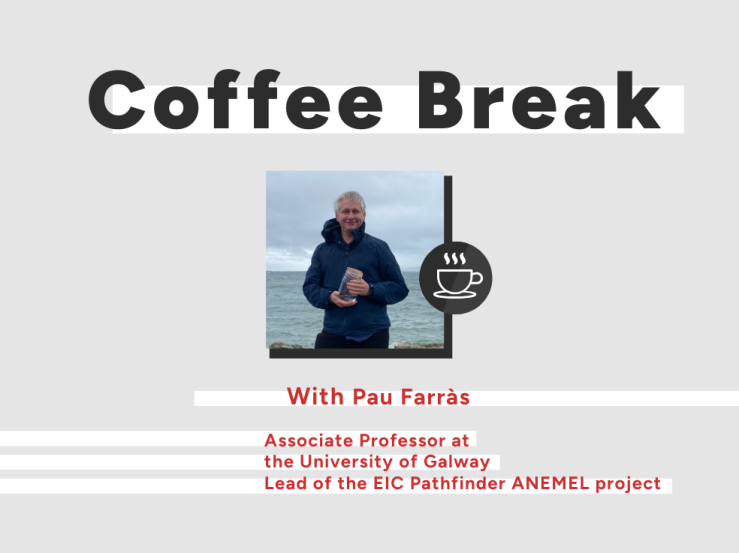Behind the groundbreaking innovation of every EIC project lies a story worth telling. In this edition of our Coffee Break series, we had a fruitful exchange with Associate Professor at the University of Galway, Pau Farràs, and the widely diverse team of the EIC Pathfinder project ANEMEL, with whom he is leading the way in the transition towards a new energy economy in Europe. Tune in to be walked through ANEMEL’s recent collaboration with the EIC Transition project, ENABLER, and the team’s latest groundbreaking research results, unlocking unprecedented solutions for water electrolysis and the production of green hydrogen!
The focus of the EIC Pathfinder ANEMEL project is on developing electrolysers that are very robust and long lasting. Being the lifetime of technologies a growing concern across Europe for their environmental impact and economic implications, could we say ANEMEL is leading the way in the transition towards a circular economy?
Definitely! ANEMEL addresses sustainability and resilience on several points. First and foremost, our team works towards developing electrolysers to produce clean hydrogen from “dirty” waters, thus preserving a precious resource – clean water – as well as offering an alternative for the storage of intermittent renewable energies, as solar and wind.
Moreover, ANEMEL researchers develop components without scarce precious metals, as platinum and toxic pollutants. This improves recyclability and contributes to creating cleaner electrochemical devices overall, helping to sustain a steady supply chain without relying on critical raw materials.
Last, but not least, ANEMEL counts on a full team of researchers specialising in life-cycle analysis (LCA) and sustainability and working with our chemists and engineers to develop a sustainable-by-design solution whilst ensuring we produce a protype that’s long-lasting and ready for the circular economy.
© ANEMEL/Agata Communications
Including partners and associated partners, ANEMEL’s project consortium consists of 11 members from 9 different countries: which are the advantages of such a diverse consortium in the electrolyser innovation sector? Do you also recall any coordination difficulties along the way?
Diversity is always a plus in science and innovation, as demonstrated by countless studies and successful projects. The ANEMEL team not only involves nine countries within the EU, UK and Switzerland but also different teams of experts, including chemists, engineers, materials scientists, sustainability consultants and even a dedicated communication company.
Although coordinating is complicated, we luckily count on a fantastic team of collaborators who are used to working across academia, SMEs, industry, and policymaking, with vast experience leading Horizon 2020 and Horizon Europe projects. Moreover, the meetings at ANEMEL, both in person and online, ensure a smooth stroll to success.
In ANEMEL, we work across Work Packages and teams as well as with other EU- and EIC-funded initiatives with similar goals, such as the EIC “Green Hydrogen” portfolio of projects.
© ANEMEL/Agata Communications
Let’s now focus on ANEMEL’s recent achievements: backed by an EIC Booster Grant, ANEMEL recently joined forces with the EIC Transition ENABLER project, focused on next-generation fuel cells. Could you further expand on this new initiative, MarketHy, and on how it could unlock new opportunities in the hydrogen sector?
The scopes of ANEMEL and ENABLER overlap in a series of solutions, including the design of more efficient electrocatalysts, the development of multi-functional membranes and research on ionomers as a means to boost the performance of electrochemical devices.
While ANEMEL works on electrolysis to generate hydrogen, ENABLER studies fuel cells to start using hydrogen as a sustainable fuel – the complementarity is clear. Therefore, it made sense to start a collaboration, and the EIC Booster Grant provided the perfect platform!
In MarketHy, ANEMEL and ENABLER will evaluate electrocatalysts for different applications, and most importantly, start investigating the scalability of solutions, techno-economic assessments and market entry strategies for these technologies. MarketHy will especially focus on platinum-group metals, to better understand the importance of working with and without them in terms of supply chains, availability, recyclability, durability, and economic impact.
Overall, the two projects will advise strategies towards the commercial success of their respective technologies to unlock new opportunities in the hydrogen sector and accelerate the transition towards cleaner solutions and a new energy economy.
ANEMEL’s team has also made significant strives in research, as demonstrated by the results from the studies conducted by the project’s partner, École Polytechnique Fédérale de Lausanne (EPFL) and published in a peer-reviewed paper and in a journal of the German Chemical Society. Looking at ANEMEL’s goals, what will these results allow for?
Besides the latest publications in Angewandte Chemie, one of the journals with highest impact-factors and visibility in the field of chemistry worldwide, ANEMEL has published over 25 scientific peer-reviewed papers.
In the spirit of open science and collaboration, ANEMEL shares its results under a Creative Commons licence in Zenodo, including communication materials like infographics and videos.
The latest research results have unlocked unprecedented solutions for water electrolysis and the production of green hydrogen, such as platinum-free catalysts that outperform other more expensive and scarce elements, and AEM electrolysers that surpass stability benchmarks by over 500.000 times – working under stressful conditions for over 800 hours.
This is especially impressive if you compare it to state-of-the-art solutions, which last scarce seconds! Overall, these advances in basic science pave the way to more affordable, scalable, sustainable hydrogen production at an industrial scale.
About ANEMEL
ANEMEL, coordinated by the University of Galway, is focused on the design of new electrolysis membranes to convert low-grade water into green hydrogen. Supported by the EIC Pathfinder, ANEMEL plans to ensure a fast commercialisation of its developed prototypes and products.
Learn more about ANEMEL by visiting the Horizon Europe database and the official project website.

DISCLAIMER: This information is provided in the interest of knowledge sharing and should not be interpreted as the official view of the European Commission, or any other organisation.

